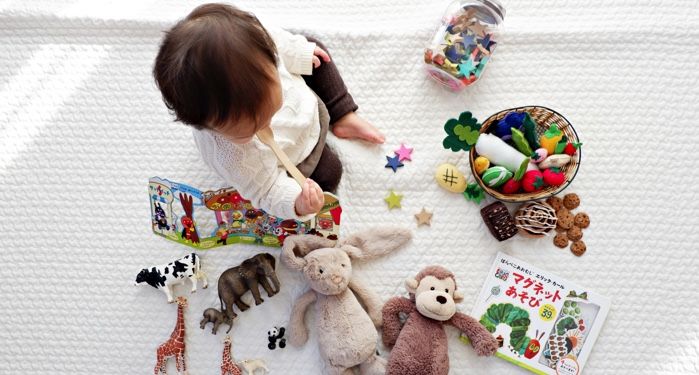
6 of the Best Baby Sign Language Books for Parents
If you are a parent, relative, or a teacher of babies, you may be searching for some of the best baby sign language books out there. Below are five books (and one coloring book) to get you and the little ones with you started communicating in a simple way. You may think of this period fondly after their little brains have soaked up everything around them and they have left you in the proverbial communicative dust (or is that just me?).
What people call Baby sign is actually adapted from American Sign Language (ASL), a visual language used by deaf, hard of hearing, and hearing signers alike. It is a language in its own right; one that is much more than just gestures or ways to spell words visually. If this is new information to you, you may find it helpful to read the Donders Institute’s blog post on Sign Language myths or the U.S.-based Kennedy-Krieger Institute’s list of common myths about signed languages.
Of course, learning baby sign is not the same as becoming fluent in one of the Sign Languages (as in American Sign or British Sign or Sign Languages of the Netherlands, etc.) of the world. If you are just interested in learning a few signs, of course there is no need to worry about fluency right from the start.
Not Just For Babies
However, the marketing around baby sign has always bothered me some. I could not quite explain my discomfort until reading something from a woman named Rachel Kolb.
Kolb’s opinion piece in the New York Times puts into words some of what has bothered me in the past. Kolb is deaf and a fluent signer, and her piece points out the disservice done to Sign Language users when baby sign is separated from ASL. Kolb’s piece is worth reading as she gives non-signers like me a lot to think about.
As someone who only encountered baby sign as separate from its source language, I did not see the real potential it in. If I had thought of it as a bridge to help me learn ASL, I would have been more committed. Of course I realize that not everyone would react that way and that promoters of baby sign do not want to scare off new learners. However, Kolb is right. It is a missed opportunity to treat signing as a temporary choice to help wait out the pre-verbal stage. Instead, we should be thinking of it as a bridge to help more adults and children learn ASL or another sign language.
The other issue that bothered me is the lack of diversity in the baby sign materials I found when I became interested in it. A few new books have come out since that time. However, there is definitely room for more by signers from different Deaf communities who want to teach others to sign. That being said, these are the best baby sign language books to get started with.
My first Baby Signs by Phil Conigliaro and Tae Wun Yu
This hardcover has an appealing design and covers a small number of signs that may be helpful to those just starting out. I prefer to start with something with a simple format, so this book appealed to me. The illustrations are bright and minimalist. However, if you prefer a bit more information, then the next book may suit your needs better.
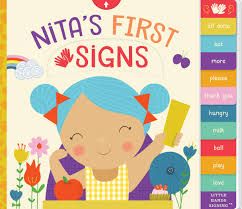 Nita’s First Signs (1) (Little Hands Signing) by Kathy MacMillan and Sara Brezzi
Nita’s First Signs (1) (Little Hands Signing) by Kathy MacMillan and Sara Brezzi
This board book covers ten common signs, setting them in context and offering pull out instructions. Macmillan is a librarian, certified ASL interpreter, and a signing storyteller. Her book offers more of a contextualized introduction to the ten signs in the book, with repetition in each story to help you and the tiny humans in your life remember the signs.
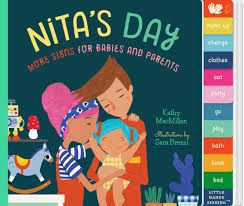 MacMillan has a second book called Nita’s Day (2) (Little Hands Signing) coming out in May 2020. It uses the same format as her first book and introduces ten more signs for adults and kids to learn in context.
MacMillan has a second book called Nita’s Day (2) (Little Hands Signing) coming out in May 2020. It uses the same format as her first book and introduces ten more signs for adults and kids to learn in context.
As an aside, MacMillan also wrote a guide to help librarians and library personnel and even some working outside libraries may find interesting. It’s called Try Your Hand at This: Easy Ways to Incorporate Sign Language Into Your Programs.
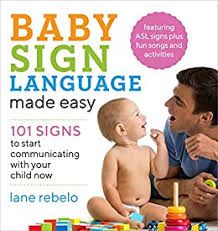 The Complete Guide to Baby Sign Language: 200+ Signs for you and Baby to Learn Together by Lane Rebelo
The Complete Guide to Baby Sign Language: 200+ Signs for you and Baby to Learn Together by Lane Rebelo
Rebelo’s first book, Baby Sign Language Made Easy, includes 101 signs categorized by the time you will most likely need them, so for instance at bath or meal times. She also includes ways to remember the signs and what to look for when your baby does their “baby best” to sign back.
Her Complete Guide is obviously more of a commitment in terms of time and energy, but for those who would like to go beyond the basics, it should help. It includes more signs of course, and also an index and a list of resources at the back, including her video dictionary which will help learners see the signs in action.
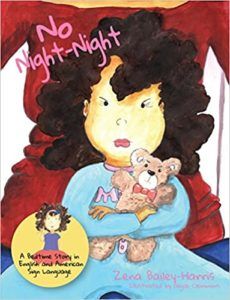 No Night-Night: A Bedtime Story in English and American Sign Language by Zena Bailey-Harris
No Night-Night: A Bedtime Story in English and American Sign Language by Zena Bailey-Harris
Zena Bailey-Harris is an ASL interpreter and this is her first book. Readers can follow her story in text and ASL, with illustrations that can help them sign along or learn the signs from it. When this was published in 2018, I somehow missed it. I am definitely hoping for more from Bailey-Harris and other ASL authors like her since there do not seem to be enough ASL stories for kids of various ages.
ASL Manual Alphabet Coloring Book by FingerAlphabet.org
While this is not exactly on baby sign, this presents coloring sheets for those interested in learning to fingerspell in a variety of Signed Languages. The one linked above is for ASL. However, there are others available including ones for New Zealand, Denmark, and the Philippines.
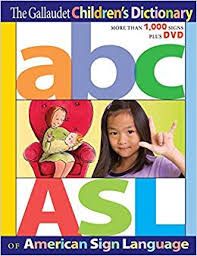 The Gallaudet Children’s Dictionary of American Sign Language by the Editors of Gallaudet University Press & Jean M. Gordon
The Gallaudet Children’s Dictionary of American Sign Language by the Editors of Gallaudet University Press & Jean M. Gordon
If you’re ready to go beyond the 200 or so that you can pick up in the previous books, then it may be time to move to The Gallaudet Children’s Dictionary of American Sign Language with its more than 1,000 signs and illustrations. Aimed at deaf, hard of hearing, and hearing children alike, this book offers both many more signs than you will find elsewhere and also puts the signs in sentences to help you understand how to use them.
Personally, I never made it that far but hopefully others will progress enough to make good use of Gallaudet University’s dictionary. The world could always use more bilingual people.
Want more? Check out our post on the best board books for babies here.














